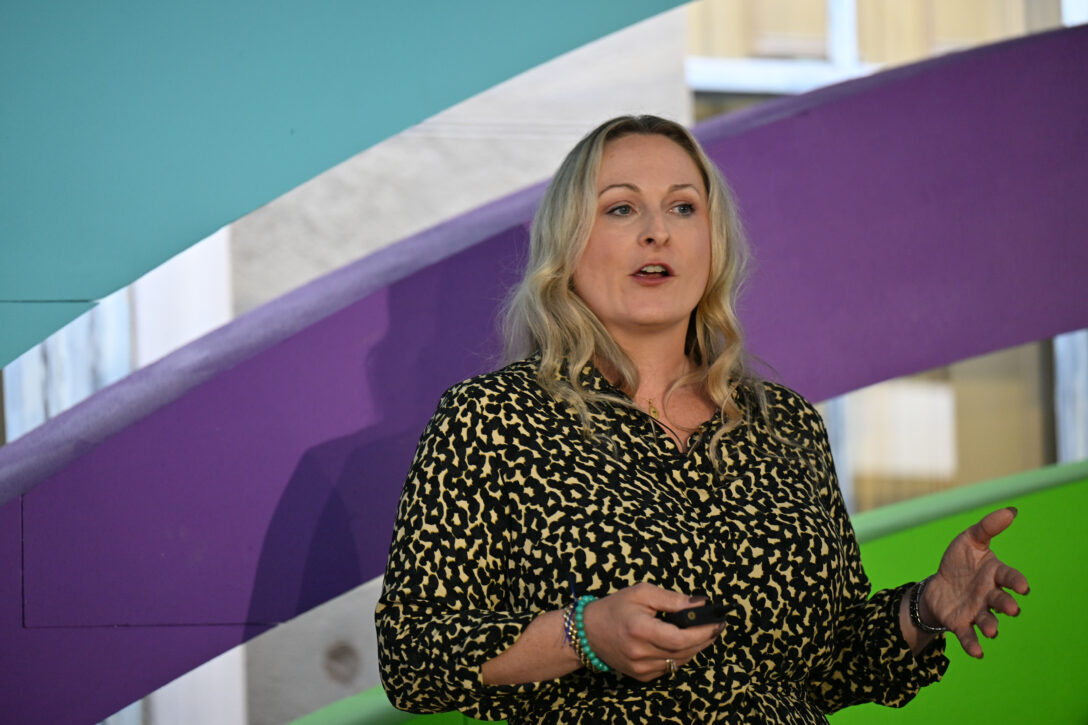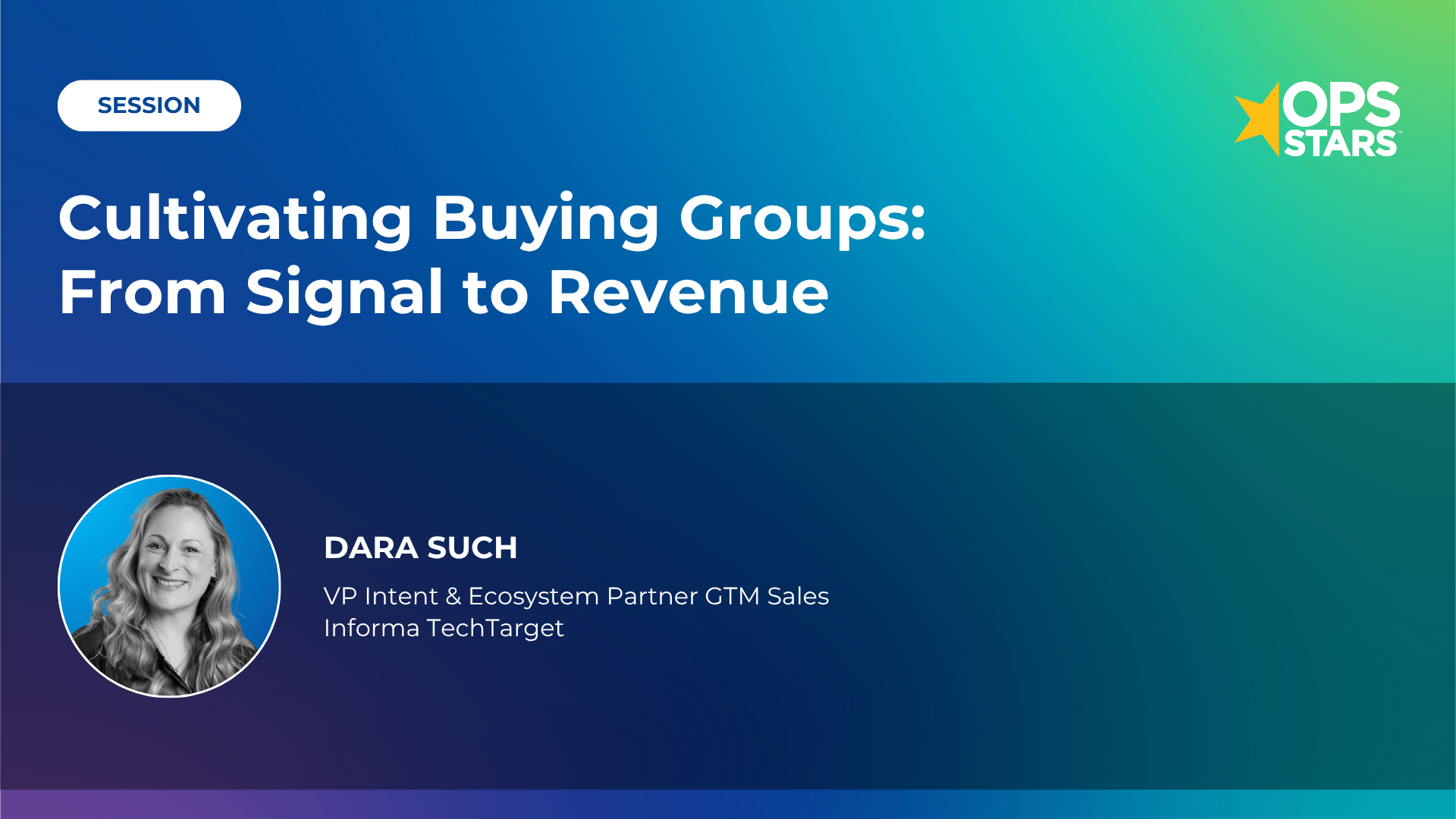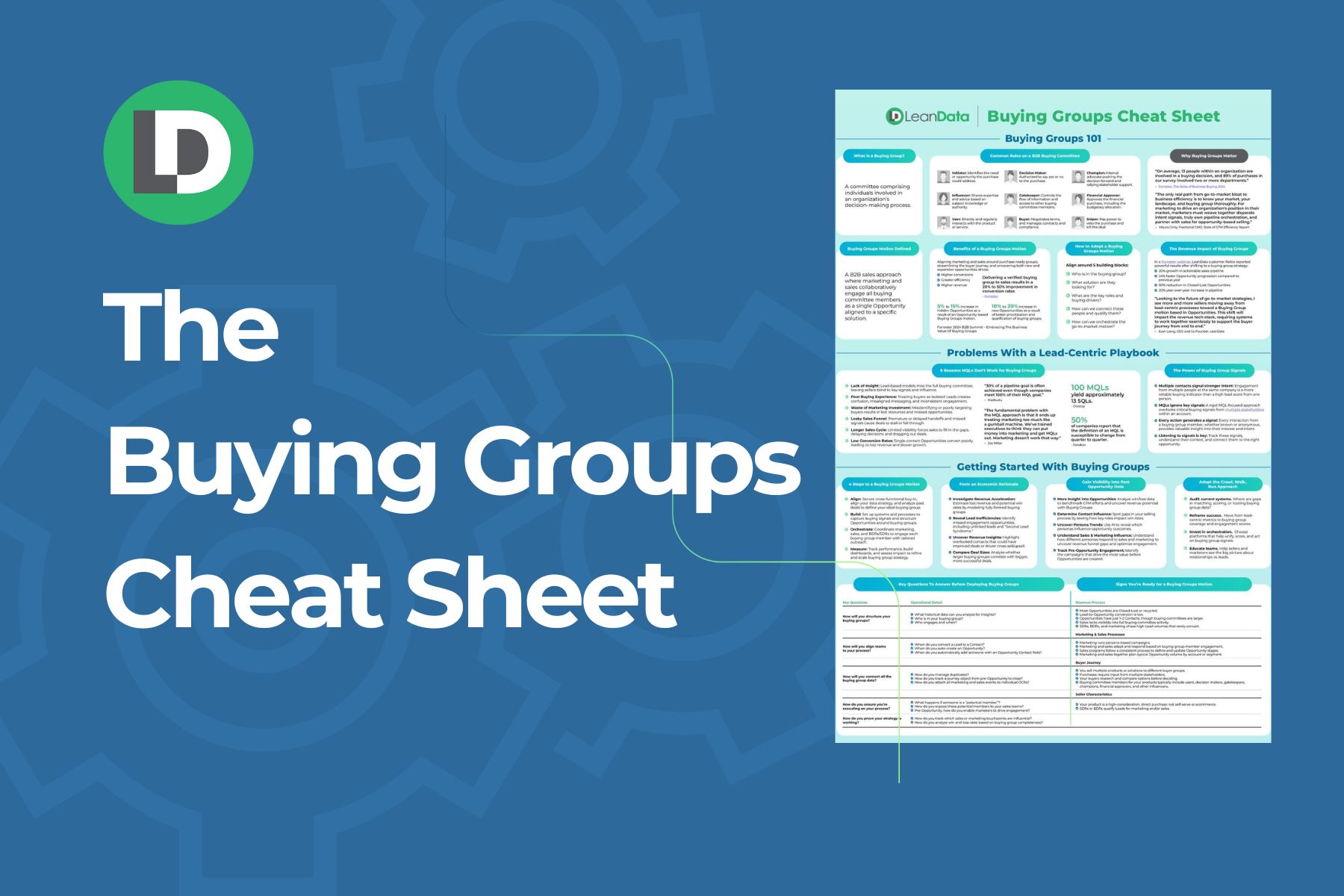Summary
In this OpsStars 2025 session, Dara Such (Informa TechTarget) breaks down how to move beyond MQLs to cultivate engaged buying groups using layered intent signals and opportunity‑centric GTM orchestration. Ideal for RevOps, MOPs, SOPs, and GTM leaders who want healthier pipeline and higher win rates. Session insight: Integrate and validate multiple signal types, focus your processes around opportunities and buying groups, then orchestrate the right actions across teams to earn trust and revenue.
Key Takeaways
- Treat buying groups like living systems: connect individuals at the account level around a shared objective to grow a reliable pipeline.
- Replace isolated “MQL” thinking with a marketing‑qualified buying group model that validates intent across first‑, second‑, and third‑party signals.
- Aggregate signals (account, person, competitive, content engagement) to see real buyer journeys, not just your funnel, and trigger coordinated, trust‑building actions.
- Meet buyers where they research (analyst/editorial sites, partners, AI assistants) with credible, multi‑format content that serves diverse stakeholders.
- Use recent, clean, and actionable data to drive personalization, prioritize outreach, and accelerate speed to lead.

Speaker
Dara Such — VP, Intent & Ecosystem Partner GTM Sales, Informa TechTarget
Dara is a revenue and intent‑data leader who helps B2B companies activate multi‑signal intelligence to identify, engage, and convert active buying groups.
What You’ll Learn
Q: How do I evolve from MQLs to buying groups?
A: Shift your operating model from lead‑centric to opportunity‑centric: validate intent across multiple sources, cluster engaged people at an account into a buying group, and define clear entry criteria for a marketing‑qualified buying group (MQBG). Then orchestrate the next best actions for the group and its members.
Q: Which signals matter most to cultivate buying groups?
A: Blend first‑party (your website and program engagement), second‑party (trusted publishers/partners), and third‑party (broader market) signals. Prioritize recent, corroborated activity tied to the problem your solution solves. Multiple, independent signals raise confidence and reduce false positives.
Q: How do I operationalize this across GTM?
A: Centralize signals, map people to accounts and opportunities, and automate playbooks that route, notify, and personalize by role. Use shared views of the journey so Marketing, Sales, and RevOps align on who is in the group, what they need next, and how to progress the opportunity.
SESSION TRANSCRIPT
Dara Such:
Thank you all for joining. This is a full-circle moment for me. I lived in San Francisco about 15 years ago, so the hyphy music you just heard is where my love for all of that came from.
There are two things I love—you already know one of them. The second is cultivating plants. I spend an awful lot of time caring for and cultivating over 400 plants in my home, which is admittedly a little obsessive. But it has taught me about the labor of love. And buying groups—shifting to a buying group methodology and moving from marketing qualified leads (MQLs) to an opportunity-centric go-to-market motion—is also a labor of love.
So be ready for a few plant references over the next 20 minutes.
If we’re going to talk about cultivating buying groups, let’s take a look at where we are. The image on the left might look familiar—a tangled mess of signals and leads that aren’t really organized around the opportunity. We think we’re helping drive revenue, but the data and actions aren’t structured in a way that supports it.
If we want to get to the image on the right—an intent-led, opportunity-centric approach that scales—it’s going to take effort, creativity, coordination, and determination.
I work with enterprise, mid-market, and startup companies at different stages of growth and maturity, and everyone’s at a different point on this journey. So instead of diving into a hands-on operational discussion, today we’ll focus on how to get buy-in—how to visualize and communicate this shift so you can actually get started.
I think of a buying group–based revenue generation motion like a tree. A healthy tree has leaves and branches that are connected and communicate with each other. Business-to-business (B2B) buying groups and the vendors they work with are no different.
You have to foster communication. If those channels break down—or if the “food and water” aren’t there—you’ll end up with an unhealthy pipeline.
Unfortunately, many of our pipelines look more like this: one lonely contact associated with an opportunity. In some client cases, it’s even zero. The average is about 1.2 contacts per opportunity. We can do better.
Those “sad little leaves” represent dormant contacts and unfollowed leads—the ones we spend so much time, money, and effort generating. That’s not how you build a healthy, reliable pipeline.
Whether you’re in Revenue Operations (RevOps), Marketing, Sales, or IT, your role is to help build the connective tissue between individuals and your organization—between the buying group and your teams—around a shared goal. The goal is to help buying groups come to their own conclusion that your organization can solve the business problem they’re trying to address.
As a visual learner, I like to illustrate this. Over the past several years, we’ve seen buyer behavior shift dramatically in the buyer’s favor. It’s tricky—we need to drive revenue, but buyers often don’t want to talk to vendors.
Buyers today prefer third-party sources and AI experts over sales reps. They’re independently building shortlists, often before ever engaging with vendors. And most already have a preferred vendor before they even speak to your team.
On the go-to-market side, you need tools and data to close that gap. You need to know which accounts are in-market and which signals actually matter—not the noisy ones. You need to know who’s involved in the buying process, and often, you don’t.
You must take all that information to build awareness, trust, and ultimately, pipeline.
The great equalizer here is data.
If we want to bridge the chasm between buyers and sellers and stabilize pipeline and revenue, we need clean, actionable data. At Informa TechTarget, we believe in the value of recent data. What a buyer did six months ago doesn’t matter as much as what they did last week. Recency leads to relevance—and relevance drives outcomes.
You can’t do any of this effectively unless you really know. And right now, a lot of teams are still guessing. You saw Palo Alto Networks’ team earlier today share how they define personas. They’re a customer of ours, and we’ve collaborated closely to expand those personas to include both known and unknown contacts.
Once you know who’s in the buying group, everything gets easier. You can make data-driven decisions instead of relying on gut feelings. You can personalize outreach so it resonates with buyers. And ultimately, you can meet their expectations—because nearly two-thirds of buyers say they’ll spend time with sellers who make it about them, not about the pitch.
As John Miller recently said, “The MQL was never what we wanted—it was just what we could measure.”
It’s time to fix that. What we actually want are engaged buying groups that show legitimate purchase intent—multiple stakeholders from a target account who are actively researching and moving through the process.
That’s a lot to unpack, so let’s break it down.
First, engaged buying groups. Historically, engagement was measured by interaction with the vendor alone. That’s risky now, because buyers engage far more with external sources—partners, competitors, and trusted content providers like Informa TechTarget. Expanding beyond your own brand signals gives you a fuller view.
Second, legitimate intent. Intent data works when used well, but false positives are common. The key is layering signals from multiple sources. When you validate intent using both first-party and third-party data, your confidence rate and ROI increase dramatically.
Finally, multiple stakeholders. You can’t just stop generating leads and doing content marketing. Instead, meet buyers where they are. Create and distribute content in the formats and on the platforms your audiences trust.
The procurement team and the technology team, for example, have very different research habits. If you’re not producing content for both, you’ll struggle to land on their shortlists.
When we work with customers pursuing a buying group strategy and opportunity-centric go-to-market motion, we don’t throw out foundational principles—we evolve them. We layer intent from multiple sources. We generate first-party signals through content engagement. We harness intent at the individual, group, and account level.
Think about all the dormant contacts sitting in your customer relationship management (CRM) system. Third-party activity about those contacts can help you identify who’s re-engaging and bring them back to life.
Then, with better data and signals, your marketing channels and tools—like email, digital advertising, and events—become far more effective.
Lastly, we now talk about marketing qualified buying groups (MQBGs) rather than individual MQLs. Every company defines these differently, but the concept is the same: a consolidated, holistic view of an opportunity across all stakeholders.
At Informa TechTarget, we’re a publishing brand at our core, but we’re also a leading provider of intent data. Buyers have always trusted us—over 50 million registered members consume research and content on our properties every day, generating more than 500 million annual intent signals.
In fact, traffic to our sites is up 26% this year, even amid the rise of AI agents. Buyers still come directly to trusted sources.
We’ve also seen over 60,000 monthly AI Overview appearances in search results—something we now track closely. Being adjacent to trusted content sources helps our clients maintain visibility in AI-driven search results.
We offer account-level intent, person-level intent, and direct engagement tools. And we’ve invested heavily to ensure seamless integration of our data into your systems, including with LeanData.
Our data is expanding rapidly. Since merging with Informa Tech last year, we’ve seen a 41% average lift across markets, along with new topics, deeper insights into content preferences, and beta programs delivering real-time, AI-ready clickstream data.
We’ll roll out this new Intent Data-as-a-Service capability in early 2026, giving customers direct access to individual user actions within their systems of choice.
To close, I encourage you to think of buying groups as living, breathing systems.
If you want to generate multiple opportunities from high-fit accounts, invest in understanding how those accounts behave—their digital body language, their research patterns—and act on those insights.
Meet buyers where they are—whether with you, your competitors, or trusted partners. Use tools like LeanData to activate those insights. Generate branded, high-value signals through content amplification. Appeal to the full range of personas and stakeholders within each buying group.
And finally, embrace the combination of AI, human interaction, and digital engagement.
We are emotional beings. We crave trust and connection. AI is a tool—but human trust still drives transactions.
So aggregate different signal types and sources to create a complete view of the buyer journey—not just your sales funnel.
Thank you for humoring my plant analogies, and I hope this helps you on your journey to cultivating a healthier, buying group–based pipeline.









